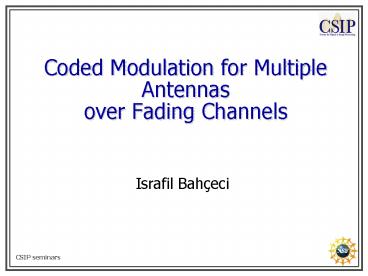Coded Modulation for Multiple Antennas over Fading Channels - PowerPoint PPT Presentation
1 / 27
Title:
Coded Modulation for Multiple Antennas over Fading Channels
Description:
Space-time trellis codes. Space-time block codes. Turbo coded modulation with ... Space-Time Trellis Codes ... Trellis Coded Unitary Space-Time Modulation ... – PowerPoint PPT presentation
Number of Views:223
Avg rating:3.0/5.0
Title: Coded Modulation for Multiple Antennas over Fading Channels
1
Coded Modulation for Multiple Antennas over
Fading Channels
Israfil Bahçeci
2
Outline
- Signaling over Wireless Channels
- Fading Channels
- Diversity techniques
- Channel Coding,
- Space-time Coding for Multiple Antenna Systems
- Space-time architectures
- Turbo- and Trellis-Coded Space-Time Modulation
3
Introduction
fading
multipath propagation and time variations ?
4
Fading in Time, Frequency and Space
Frequency selective fading (due to delay
spread)
abcdefghijklmnopq
Time selective fading (due to Doppler spread)
Space selective fading (due to delay spread)
5
Signaling over Fading Wireless channels
diversity techniques
Frequency selective fading (due to delay
spread)
Frequency diversity
aeimqbfjncskodhlp
Time diversity Channel coding and interleaving.
Antenna diversity
6
Channel coding
- A sophisticated form of time diversity
- Different techniques
- linear block codes (Hamming, Hadamard, Golay,
BCH, etc.) - convolutional codes
- code concatenation (parallel, serial, product
codes, etc.) - turbo codes
- trellis coded modulation
- turbo coded modulation
Combined space and time diversity
- multiple transmit and receive antennas are used.
- robust to variations of the channel.
- high spectral efficiencies can be achieved.
7
Multiple antennas at the transmitter and the
receiver
8
Capacity Results for known CSI
- memoryless channel, Rayleigh flat fading
- C roughly linear with the smaller of the
number of the - transmitter and receiver antennas.
- i.e., if , the capacity
increases m bits/s/Hz - for every 3 dB increase in signal-to-noise ratio
(SNR).
9
Space-time Codes
- Combination of channel coding/modulation with
multiple - antennas.
- Encoder generates M elementary signals to be
transmitted - simultaneously.
If CSI is available
- Space-time trellis codes
- Space-time block codes
- Turbo coded modulation with antenna diversity
- Layered Space-Time Codes, i.e., BLAST
10
Space-Time Trellis Codes
- Diversity order is Nr, where r is minimum rank of
BS-S over the set of two tuples of distinct
codewords. - Coding gain is (?1 ?2 ?r)1/r, where ?i are
non-zero eigenvalues of BBH.
Code construction
ML Decoding
Branch metric at time t
Viterbi algorithm is then used to find the path
with the Lowest accumulated metric.
QPSK constellation
M2, N1, R2 b/s/Hz, 4-PSK, 4-states, Diversity
order is 2.
11
BLAST (Bell Labs Layered Space-Time)
- As M and N increase, complextity with ML decoding
increase - Suboptimal design but still achieving most of the
capacity - Layered space-time codes, processing higher
dimensional signals with the use of 1-D codes.
Antennas ?
Transmission time ?
12
(No Transcript)
13
- cancellation
- nulling
14
Capacity Results for no CSI case
- Block fading channel, T coherence time of the
channel. - Capacity does not increase as number of transmit
antennas increases beyond the coherence time! - Capacity achieving signals have considerable
structures - Isotropically distributed random vectors x
Diagonal random matrix - For MN, the capacity increases by K(1-K/T)
bits/s/Hz for every 3 dB SNR increase where K
min(r, T/2).
15
Space-Time Codes when CSI is not available
- Unitary Space-Time modulation
- Differential Space-Time Modulation schemes
- i.e., differential encoding of Group Codes
(comprising of matrices), similar to the ordinary
DPSK modulation for single antenna trasnmission.
16
Unitary Space-Time Modulation
- Block Rayleigh fading
- Unitary space-time (UST) signals achieves
capacity.
- Information is carried on the subspace spanned
by orthonormal signals that are sent to transmit
antennas.
- Large signal constellations can be generated
- systematically.
17
Turbo Coded Unitary Space-Time Modulation
Block diagram of turbo coded modulation
Block diagram of turbo code
18
Decoding
Find the likelihood values for transmitted bits
and use them as if they are observations from
BPSK modulation over AWGN channel
Block diagram for decoder.
19
L number of signals in the constellation
20
T8, L256, M2, N1, R 7/8 b/s/Hz
21
T5, L 32, 1024, M2, N1, R 1 b/s/Hz
22
Trellis Coded Unitary Space-Time Modulation
8-state encoder and L 8 USTM and uncoded L 4
USTM schemes
0,1,7 denote the UST signals
23
Optimal Decoding
where is the received signal.
- can be implemented using Viterbi algorithm
Code Design
- Given the constellations
- Set Partitioning (similar to Ungerboeck Rules)
- small ? larger separation between signal
pairs and - where s.t. are
singular values of - Parallel transitions should be assigned to
members of the lowest level partition. - Adjacent transitions should be assigned the
next available partition.
24
- example, L 8 USTM
25
M2, N1, R1/4 b/s/Hz. 8-state L8 USTM schemes
compared with uncoded L4 USTM.
26
M2, N1, R1 b/s/Hz. 256-state L512 TCM
compared with L256 uncoded modulation.
27
Conclusions
- Multiple antennas have great potential to
provide large transmission rates, particularly
required by multimedia applications. - Space-time coding technology with other
techniques such as array processing, OFDM, CDMA,
etc. promise large performance improvement. - Further research on space-time coding for
various channel models needs.































